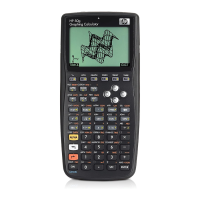10 Getting Started
Getting Started10
29. There are two major types of solvers on the 50g: numeric and symbolic. Let's examine the Numeric Solver first. Press
@ followed
by 7(N.SLV). A choose box appears. Press 3 and note how the highlight jumps to the corresponding item. Press 1 to jump back to
Solve Equation and press ENTER.
30. A full screen solver appears (see Figure 15). To begin, we must enter an equation to solve. Rather than typing it all in at once, let's
use the EquationWriter again. Press
@ followed by ³ (EQW). Now let's paste in the formula we copied from the last
example by pressing
@ followed by L (PASTE). The whole expression is highlighted as shown in Figure 13. Let's rewrite this
to be
. Press ! followed by \ (DEL) to remove the square root function (see Figure 16). Now press the CURS
menu key and notice a cursor appears on a box around . Use the cursor keys to move the cursor and the box around the
equation. As you move, note how you can select individual items, or groups of the whole expression. Use the RIGHT and DOWN
cursor keys so the box surrounds only the 20 and then press ENTER to select 20 (see Figure 17).
31. Press the ] key to access the letters of the alphabet printed in yellow on the keys. Press ] followed by F1 (A) and note how
the 20 is replaced by a letter A (see Figure 18). Press the cursor keys as follows: UP UP LEFT DOWN to highlight the 14. Press
]
followed by F2 (B) to replace the 14 with a letter B (see Figure 19). Press the cursor keys, UP UP, followed by
! then RIGHT
cursor. The
term moves to the left (see Figure 20). Press ! then LEFT cursor and it moves back. Position it so the equation
reads . Press UP until the entire expression is highlighted. Press @ followed by Wto insert an equals sign, =, then
] followed by F3(C) Q 2. You now have the full (see Figure 21). Press ENTER.
Figure 15 Figure 16 Figure 17

